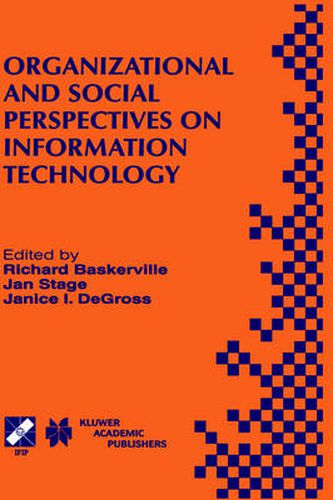Readings Newsletter
Become a Readings Member to make your shopping experience even easier.
Sign in or sign up for free!
You’re not far away from qualifying for FREE standard shipping within Australia
You’ve qualified for FREE standard shipping within Australia
The cart is loading…






This title is printed to order. This book may have been self-published. If so, we cannot guarantee the quality of the content. In the main most books will have gone through the editing process however some may not. We therefore suggest that you be aware of this before ordering this book. If in doubt check either the author or publisher’s details as we are unable to accept any returns unless they are faulty. Please contact us if you have any questions.
The purpose of this work is to denote the transition from past to current to future investigations of the relationships and interactions among four major components: information systems (IS), information technology (IT), organizations, and society. These investigations share a primary focus on the interrelationships, not on the components themselves. The contributions to the book deal with the history of IS theory and technology, with the directions faced by those sharing the concerns of the field in its future research, and with attempts to draw these two views together. Five discourses collectively answer the key question: What is the status of IS, as related to organizations and society, now that we stand at the juncture of the new century? These discourses deal with the fundamental concepts, the classical and novel challenges, the conceptualization processes, automation, and new technology. What is our story as we turn the first century of the information age? We believe that IT is even more critical in social interaction in organizations, that human language barriers form fundamental roadblocks to IT implementation, that newer forms of IS integrate horizontally rather than vertically, and that the mix of skills and knowledge is changing. We also find that we lack integrated approaches to risk management, that new social costs are being unleashed on people by the wiring of society, and we are rushing headlong into globalized systems with our eyes closed. We reveal how the old end-user tension between central control and innovation has reappeared in the intranet world, how IT has been converted into a cultural commodity, and explore how the video screen has become the central means for discovering our relevance to our universe. We explore the surprising ways that machines have acquired human status, not through robotics, but rather through social construction. We discover new norms for defining the relationships and exchanges between human beings and computers.
$9.00 standard shipping within Australia
FREE standard shipping within Australia for orders over $100.00
Express & International shipping calculated at checkout
This title is printed to order. This book may have been self-published. If so, we cannot guarantee the quality of the content. In the main most books will have gone through the editing process however some may not. We therefore suggest that you be aware of this before ordering this book. If in doubt check either the author or publisher’s details as we are unable to accept any returns unless they are faulty. Please contact us if you have any questions.
The purpose of this work is to denote the transition from past to current to future investigations of the relationships and interactions among four major components: information systems (IS), information technology (IT), organizations, and society. These investigations share a primary focus on the interrelationships, not on the components themselves. The contributions to the book deal with the history of IS theory and technology, with the directions faced by those sharing the concerns of the field in its future research, and with attempts to draw these two views together. Five discourses collectively answer the key question: What is the status of IS, as related to organizations and society, now that we stand at the juncture of the new century? These discourses deal with the fundamental concepts, the classical and novel challenges, the conceptualization processes, automation, and new technology. What is our story as we turn the first century of the information age? We believe that IT is even more critical in social interaction in organizations, that human language barriers form fundamental roadblocks to IT implementation, that newer forms of IS integrate horizontally rather than vertically, and that the mix of skills and knowledge is changing. We also find that we lack integrated approaches to risk management, that new social costs are being unleashed on people by the wiring of society, and we are rushing headlong into globalized systems with our eyes closed. We reveal how the old end-user tension between central control and innovation has reappeared in the intranet world, how IT has been converted into a cultural commodity, and explore how the video screen has become the central means for discovering our relevance to our universe. We explore the surprising ways that machines have acquired human status, not through robotics, but rather through social construction. We discover new norms for defining the relationships and exchanges between human beings and computers.